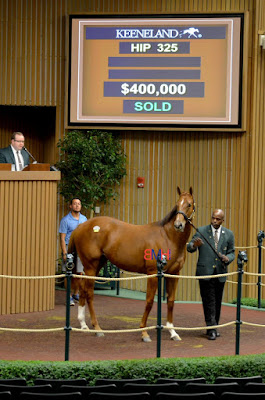Commercial Market Alive and Strong for First Year Sires
When one mentions that the racehorse industry has become commercialized,
they only have to point to the yearling sales to prove their point.
This year’s
first season sires are an example of that, with the racing industry getting to
see a large sample of these new sires’ offspring a year before they make it to
the track.
 |
| Union Rags has 75 yearlings selling this summer |
On first glance, WinStar Farm’s Bodemeister, who had 135
foals born in 2014 looks to be the freshman stallion most visited by commercial breeders.
Of those 135 born, 98 have either sold at a Fasig-Tipton yearling sale this
summer or will sell at Keeneland September next week (that number doesn’t include
outs from the Fasig sales, those sold at other sales companies’ sales or
Fasig-Tipton’s October sale in Lexington).
However by percentages, the most commercial honor goes to Lane’s
End’s The Factor, who has a little over 75 percent of his first crop of
yearlings in the big sales this year.
THE FACTOR
After the last few years that The Factor’s sire War Front
has had, it has probably been assumed that The Factor was going to be a sought
after first year sire at the sales. The first real indication that it was going
to be a big year for The Factor was at Fasig-Tipton's July Sale when five of his yearlings sold
for a gross amount of $720,000 (high seller went for $250,00) with a median
price of $150,000. That was topped a month later when the
stallion had six yearlings (the second most of any freshman on this list)
entered at the Fasig-Tipton Saratoga Selected Yearlings Sale with a median of
$312,500 and a gross total of $2.32-million.
The biggest fireworks of the night for the stallion came from the last
two yearlings to go through the ring with a $600,000 purchase by Crupi’s New
Castle Farm followed by a winning bid of $750,000 by Willis Horton. Not too
shabby for a stud fee of $15,000.
While you would think that some of The Factor’s 65 Keeneland
September entries may have come after those results, that isn’t the case as all
entries for Keeneland September had to be in by May 1, 2015.
Interestingly, from the 40 freshmen sires I looked at (all
U.S.-based), by percentages some of the stallions I assumed would be bred more
by breed-to-race owners instead of breed-to-sale have more selling than those that
would appear more commercial.
Looking at the table below, an example of this is Aikenite.
Three of the “big” stallions from this crop predictably top the list of
percentage of foals being sold in the four sales looked at, but Aikenite has
nine of his 14 foals cataloged to sell, putting him in that No. 4 position
above stallions like Preakness winner Shackleford and 2-year-old champion
Hansen (whose yearlings are the only crop of U.S.-breds he’ll have).
2015 FRESHMEN SIRES BY PERCENTAGE OF YEARLINGS SELLING
Showing that the racing industry is about searching for the
next big thing, the new sires rank right up there with the current top 10 sires
by percentage of yearlings going through the sales ring.
Bodemeister and The Factor actually top the percentages of those top 10 sires,
but with Bodemeister having more to sell than any of the top 10 sires and only
Malibu Moon having more cataloged than The Factor, Union Rags and Gemologist
that number makes sense.
One interesting observation is that Tapit and his sons seem
to have a little lower percentage of yearlings than their contemporaries.
Of the top 10 leading sires, Tapit only has 54.14 percent of
his 2013 foals selling even though they do sell very well. However, what may be
to blame for less Tapits selling compared to the others is his $125,000 stud
fee. While he gets many of the top mares, a lot of those breeders are also in a
position to keep the resulting foals rather than sell them.
As for his freshman sire sons Tapizar, who entered the market at a stud
fee of $15,000, got a healthy number of 103 live foals on the ground in 2014. Fifty-nine of those are selling in the big sales this summer and fall, but that number
places him only seventh on the list of highest percentages of yearlings sold
with nearly 20 percent less selling than The Factor.
Hansen, who entered stud at a fee of $12,500 at Coolmore's Ashford before being sold to South Korea, has 53 of his
102 foals selling for a 51.96 percent cataloged rate. Those breeders who
entered his yearlings in sales must be feeling decent going into the Keeneland
sale with his two yearlings at the Saratoga Selected Yearlings sale going for
$200,000 and $250,000. He didn’t see as big of prices at The July Sale but the
Hansens held their own with one bringing $125,000 and another $84,000 for a
median of $84,000 from the three sold (one was a private sale).
However, while the percentages of Tapit (and his sons') yearlings
to go through the ring are lower than others, there will be more than enough to
choose from at Keeneland with the three mentioned having a combined 147 in the
sale before outs.
2015 TOP 10 U.S. SIRES BY PERCENTAGE OF YEARLINGS SELLING
The business of racing always comes down to who is
best on the track, whether it be the most successful stallions or racehorses. But finding out which stallion buyers will want in the sales ring is also a big,
but potentially rewarding, gamble.
If the percentage of yearlings by freshmen sires going through
the ring is any indication, many have taken that gamble and are looking to
prove that the commercial market is alive and strong again this year.





Comments
Post a Comment